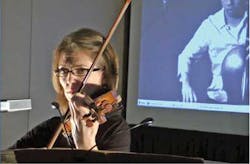HIGH-SPEED VIDEO: Low-latency networks enable remote collaboration with high speed
Networks such as Internet2 from the Internet2 Consortium (www.internet2.edu) and the Gruppo per l'Armonizzazione delle Reti della Ricerca (GARR) from the Italian Research and Education Network (IREN; www.garr.it) provide advanced high-speed network services to the academic and scientific communities in the Unites States and Italy.
Using thelow latency and high speed offered by such networks, Italian engineers have developed audio-video conferencing software called LOLA that allows musicians separated by thousands of miles to play together seamlessly (see figure). The low-latency software reduces the lag time it takes for live sound and video to travel over a network and demonstrates a delay approximately equal to what it would take sound to travel from one side of a stage to the other.
To successfully network a live musical performance, the round trip from instrument to human ear and back must be below 60 msec. LOLA reduces that delay to as low as 20 msec; even adding the network latency (from 0–25 msec at 3000 miles distance), the system fools the ear into believing that all the musicians are in the same place.
Claudio Allocchio, the manager of GARR's advanced application and innovation department, and Carlo Drioli, an audio/video engineer working in the Computer Science Lab at the University of Udine (www.uniud.it) and at the Giuseppe Tartini Music Conservatory (www.conservatorio.trieste.it), wrote the audio-video transmission software to reduce transmission latency, resulting in an impression shared by both performers and the audience that all the musicians on the network were in the same venue.
To digitize images of the performers, Allocchio and Drioli choose initially to use monochrome analog cameras rather than digital models to reduce network bandwidth. Single cameras are interfaced to a single-channel, PC-based ALT-PCE-AN1 frame grabber fromBitFlow (www.bitflow.com). Allocchio is currently working with BitFlow to allow a number of different analog monochrome and color cameras to be deployed with LOLA and is exploring the use of digital cameras and interfaces such as CoaXPress for next-generation systems.
After images and sound are digitized, they are transmitted over the network. Internet2 provides guaranteed bandwidth up to 1 Gbits/sec to connected sites. Since monochrome VGA images at 30 frames/sec consume approximately 100 Mbits/sec bandwidth, these transmission rates are currently beyond the reach of the public Internet. While Internet2 and similar networks create a round-trip, East-to-West US coast latency of approximately 25 msec, most public Internet services create a round-trip latency greater than 200 msec, making collaboration with other musicians over public networks in near-real time impossible at present.
At the October 2012 Internet2 Fall Member Meeting in Philadelphia, PA, musicians separated by hundreds of miles showcased the LOLA system. Violinist Marjorie Bagley from the University of North Carolina (UNC) performed from Philadelphia with cellist Cheng-Hou Lee at the Northern Illinois University School of Music (NIU). A video of the performance can be found athttp://bit.ly/T4Vaej.
After successful demonstrations in the United States and Europe, there are now a number of sites that have built or are building their own LOLA systems, says Allocchio. According to Paul Bauer, director of the NIU School of Music, "People are now talking of rehearsing in advance of guest appearances. Normally a guest artist may arrive the day before a concert. Now rehearsals could take place weeks or months in advance."

